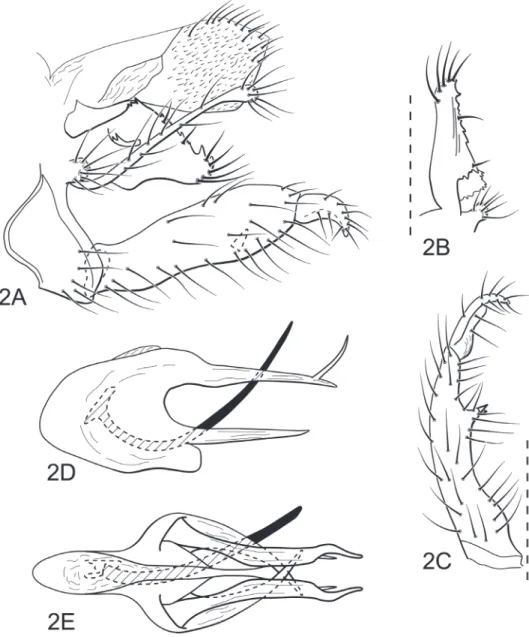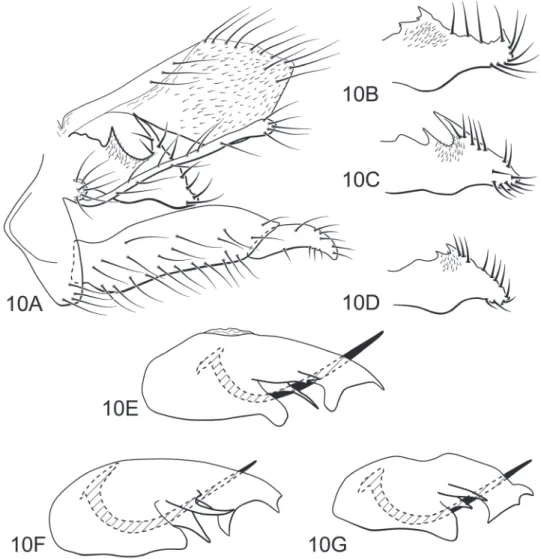Three new species of
Atopsyche
Banks
(Trichoptera, Hydrobiosidae) from Brazil
Allan P. M. Santos1,2,3,†, Ralph W. Holzenthal3,‡
1 Departamento de Zoologia, Instituto de Biologia, Universidade Federal do Rio de Janeiro, P.O. box 68044, Rio de Janeiro, RJ 21941-971, Brazil 2 CAPES Foundation, Ministry of Education of Brazil, Brasília, DF 70040-020, Brazil 3 Department of Entomology, University of Minnesota, 219 Hodson Hall, 1980 Folwell Ave., St. Paul, Minnesota, 55108, USA
† urn:lsid:zoobank.org:author:FDBB2390-430F-4769-A3A3-E8DD1CF36EBC
‡ urn:lsid:zoobank.org:author:C27A1C49-F372-4232-A49C-B8B5F753CC70
Corresponding author:Allan P. M. Santos (a.santos@ufrj.br)
Academic editor:Christy Geraci | Received 25 May 2012 | Accepted 20 June 2012 | Published 11 July 2012 urn:lsid:zoobank.org:pub:F391D3A7-0F39-4818-87D7-5AFD9D920C3B
Citation: Santos APM, Holzenthal RW (2012) hree new species of Atopsyche Banks (Trichoptera, Hydrobiosidae) from Brazil. ZooKeys 207: 65–78. doi: 10.3897/zookeys.207.3419
Abstract
hree new species of Atopsyche Banks (Hydrobiosidae) from Brazil are described and illustrated: Atopscyhe
(Atopsaura) blahnikisp. n., Atopsyche (Atopsyche) paraunasp. n., and Atopsyche (Atopsaura) galharadasp. n. Additional illustrations of the male genitalia of A. urumarca Schmid are provided, including its popula-tional variation. Also, we provide new state records for 2 species: A. (Atopsyche) urumarca from São Paulo, and A. (Atopsaura) plancki Marlier from Santa Catarina.
Keywords
Atlantic forest, Atopsyche, Brazil, caddisly, Hydrobiosidae, Neotropics
Introduction
Atopsyche Banks constitutes the most diverse genus in the family Hydrobiosidae, with
over 120 described species (Holzenthal and Cressa 2002, Holzenthal et al. 2007). he genus occurs from the southwestern United States to northern Argentina, but it www.zookeys.org
is replaced by other genera of Hydrobiosidae in the Chilean subregion (Holzenthal and Cressa 2002). Schimd (1989) provided a world revision of the family Hydro-biosidae, including comments on the classiication and phylogeny of Atopsyche and descriptions of several new species. Currently, 19 species are recorded from Brazil, of which only 2 were recorded after Schmid (1989): A. chirihuana Schmid, originally described from Ecuador; and A. erigia Ross, originally described from Mexico (Blah-nik et al. 2004). Following Schmid (1989), Atopsyche species are divided into three subgenera, based on features of the male genitalia: Atopsaura Ross, Atopsyche Banks,
and Dolochorema Banks.
In this paper, we describe 3 new species of Atopsyche from southeastern Brazil. hese additional species bring the number of known caddislies species from Brazil to 569, but many species of this and other genera remain undescribed. In addition, we illustrate variations in the male genitalia of A. urumarca Schmid, and provide new state distributional records of A. urumarca from São Paulo and A. plancki
Marlier from Santa Catarina.
Material and methods
Morphological terminology used in this paper follows that presented by Schmid (1989). he lactic acid method (Blahnik et al. 2007) was used for specimen prepara-tion. Genital structures were observed and illustrated with a compound microscope, equipped with a drawing tube. Pencil sketches were scanned and placed into an Adobe Illustrator (v. 13.0.0, Adobe Systems Inc.) document to produce a digital illustration. Descriptions provided for new species were made using the software DELTA (Dallwitz et al. 1999). Holotypes are deposited in the Museu de Zoologia, Universidade de São Paulo, São Paulo, Brazil (MZSP). Paratypes and other mate-rial examined are deposited in the MZSP and also in the University of Minnesota Insect Collection, St. Paul, Minnesota, USA (UMSP), the National Museum of Natural History, Smithsonian Institution, Washington DC, USA (NMNH), and the Coleção Entomológica Prof. José Alfredo Pinheiro Dutra, Universidade Federal do Rio de Janeiro, Rio de Janeiro, Brazil (DZRJ).
Taxonomy
Atopsyche (Atopsaura) blahniki sp. n.
urn:lsid:zoobank.org:act:17398E47-24AC-45A6-8FEF-CF2B3A9BBFE2 http://species-id.net/wiki/Atopsyche_blahniki
Figs 1, 4, 7
append-age as long as the second article, and a phallotheca with long paired processes, apically upturned and narrow. However, Atopsyche blahniki sp. n. difers from A. zernyi by the narrower parapod, longer ilipod (exceeding length of parapod), and in the apices of the paired processes from the phallotheca, which bear several spines on their lateral edges. Figure 1.Atopsyche (Atopsaura) blahniki sp. n. Male genitalia: A lateral B parapod, lateral C parapod and preanal appendage, dorsal D inferior appendage, ventral e phallic apparatus, lateral F phallic apparatus, dorsal. Abbreviations: aed aedeagus il ilipod inf app inferior appendage par parapod phal phallotheca
Male. Forewing length 5.5 mm (n=1). Overall body color brown; antennal scape brown, with long brown setae, pedicel brown, basal lagellomeres yellow, apical lag-ellomeres brown; setae of palps yellow; frons and vertex of head with long, erect brown and whitish setae; legs yellowish brown, coxae and femora of forelegs darker brown. Forewings brown; erect setae on veins forming irregular pattern of alternate dark brown and yellow setae; apex of wing with fringe of alternating patches of dark brown and yellow setae. Forewing venation complete (Fig. 4A); R1 branched; stem of fork I about twice its length; fork II long, sessile; stem of fork III equal to its length; fork IV long, sessile; stem of M almost straight between m-cu crossvein and irst fork of M; fork V long, narrow; Cu2 long, converging near fused anal veins; apex of fused anal veins very short. Hind wing (Fig. 4B) with Sc and R1 fused api-cally; forks I, III, and V present, the irst with a short stem, the last long with a short stem, stem of fork III equal to its length; forks II and IV absent; M3+4 not reaching wing margin; Cu2 long and almost straight; 1A long and sinuate. Nygmas indistinct in both wings. Tergum II with pair of prominent glands at posterolateral margin (Fig. 7A); tergum III with pair of prominent gland at anterolateral margin, lined at opening with minute setae (Figs 7A, 7B). Sternum V with pair of small, rounded glands on anterolateral margins (Fig. 7C). Sterna VI and VII with prominent spine-like ventral processes on posteromesal margins.
Male genitalia. Segment IX, in lateral view, long (Fig. 1A). Parapod narrow,
simple, with small dorsolaterally directed tooth-like projections and short, stout se-tae (Figs 1A, 1B, 1C). Filipod long, slender, with elongate sese-tae along length, apex attenuate (Fig. 1A). Preanal appendage short, rounded, setose (Figs 1A, 1C). Inferior appendage, irst article long, slightly widened apically, otherwise relatively narrow and of uniform width, with subtriangular apical process, nearly equaling second article in length (Figs 1A, 1D); second article small, with subacute apex and small rounded carina ventrally (Figs 1A, 1D). Proctiger, in lateral view, broadly widened apically, with truncate apical margin, covered with minute setae, apicodorsal mar-gin with long setae (Fig. 1A). Phallic apparatus complex (Fig. 1E, 1F); phallotheca broadly rounded basally, with narrow ventral process articulating with inferior ap-pendages (Fig. 1E); posteriorly divided into long, paired processes (Fig. 1F); pro-cesses apically upturned and narrow, covered with minute setae and bearing spines on lateral edges (Figs 1E, 1F); aedeagus an elongate, stout, spine-like structure, with slight ventral curvature near base (Fig. 1E).
Holotype male. BRAZIL: Rio de Janeiro: Cachoeiras de Macacu, Rio Souza,
16°26.567'S, 42°37.957'W, 150 m, 16.iii.1996, Holzenthal, Rochetti & Oliveira (pinned) (UMSP000031906) (MZSP).
Paratypes.BRAZIL: Rio de Janeiro: same data as holotype, 23 females (pinned)
(17 females, UMSP; 2 females, NMNH; 2 females, MZSP; 2 females, DZRJ).
Etymology. his new species is named in honor of Dr. Roger Blahnik, who
Atopsyche (Atopsyche) parauna sp. n.
urn:lsid:zoobank.org:act:D90947CD-CF4E-44EA-9819-D47E65CCF7F6 http://species-id.net/wiki/Atopsyche_parauna
Figs 2, 5, 8
Diagnosis. his new species is most similar to A. jaba Blahnik and Gottschalk,
de-scribed from Costa Rica. hese two species share a similar mesal process on the irst ar-ticle of the inferior appendage and the complex phallotheca, with paired processes pos-teriorly. Atopsyche parauna sp. n. can be distinguished from A. jaba and other Atopsyche
species by the broad parapod, in lateral view, with the dorsolateral margin serrate and with a midlateral spinose projection, whereas in A. jaba, the parapod has 2 prominent spines. In addition, the second article of the inferior appendage is shorter and slightly hooked in the new species, and the phallotheca is posteriorly divided into 2 long, paired processes, the dorsal one birfucate apically and the ventral one curved mesally.
Male. Forewing length 5.0–5.5 mm (n=10). Overall body color brown; antennal
scape brown, with long stramineous setae, pedicel brown, basal lagellomeres yellow, api-cal lagellomeres brown; setae of palps yellow; frons and vertex of head with long, erect brown and whitish setae; legs yellowish brown, coxae of all legs darker brown. Forewings brown; erect setae on veins forming distinct mottled pattern of alternate dark brown and yellow setae, with dark brown setae along costal margin; apex of wing with fringe of al-ternating patches of dark brown and yellow setae. Forewing venation complete (Fig. 5A); R1 branched; stem of fork I equal to its length; fork II long, sessile; stem of fork III equal to its length; fork IV long, sessile; stem of M slightly curved between m-cu crossvein and irst fork of M; fork V long, narrow; Cu2 long, converging near fused anal veins, crossvein near apex forming small cell on posterior margin of wing; apex of fused anal veins very short. Hind wing (Fig. 5B) with Sc and R1 fused apically; forks I, III, and V present, the irst with a short stem, the last long with a short stem, stem of fork III longer than its length; forks II and IV absent; M3+4 reaching wing margin; Cu2 long and almost straight; 1A long and strongly curved, with row of elongate setae along its length. Nyg-mas indistinct in both wings. Terga III and IV with pair of prominent rounded glands at anterolateral margin, lined internally with minute setae (Fig. 8A). Sternum V with pair of small rounded glands on anterolateral margins, with a keel-like projection (Fig. 8B). Sterna VI and VII with prominent spine-like ventral processes on posteromesal margins.
Male genitalia. Segment IX, in lateral view, short (Fig. 2A). Parapod broad, with
mar-Figure 2.Atopsyche (Atopsyche) parauna sp. n. Male genitalia: A lateral B parapod and preanal append-age, dorsal C inferior appendage, ventral D phallic apparatus, lateral e phallic apparatus, dorsal.
Holotype male.BRAZIL: Minas Gerais: Rio Paraúna, 3 km S Santana do Ria-cho, 19°10.986'S, 43°43.485'W, 650 m, 11.xi.2001, Holzenthal, Paprocki, Blahnik & Amarante (pinned) (UMSP000080716) (MZSP).
Paratypes. BRAZIL: Minas Gerais: same data as holotype, 2 males, 3
fe-males (pinned) (UMSP); Cardeal Mota, Cachoeira Véu da Noiva, 19°18.912'S, 43°36.260'W, 800 m, 12.xi.2001, Holzenthal, Paprocki, Blahnik & Amarante, 2 males (pinned) (DZRJ); Rio Cipó, Cachoeira de Baixo, 19°20.553'S, 43°38.531'W, 750 m, 10.xi.2001, Holzenthal, Paprocki, Blahnik & Amarante, 3 males (pinned) (2 males, NMNH; 1 male, UMSP).
Etymology. his species is named after the river where the holotype was collected,
that means “black river” in the Tupi-guarani language.
Atopsyche (Atopsaura) galharada sp. n.
urn:lsid:zoobank.org:act:4664284A-65D7-4F52-8ADB-8E66C1EAF4C2 http://species-id.net/wiki/Atopsyche_galharada
Figs 3, 6, 9
Diagnosis. his is a distinctive new species in the genus, belonging to the A. longipennis
Ulmer group of the subgenus Atopsaura. Atopsyche galharada sp. n. resembles A. ayah-uaca Schmid and A. plancki Marlier in the absence of ilipods and in the simple phal-lotheca. he new species can be distinguished from the others by the broader parapod with 2 carinas bearing tooth-like processes. he new species and A. plancki are similar in the short and broad irst article of the inferior appendage, with an apical process, but in the new species this process is longer and the second article of the inferior append-age is broad in ventral view, and slightly hooked in lateral view. Also, A. galharada has the proctiger with a broad lateral sclerotized projection, and the phallotheca posteriorly divided into long, paired langelike processes, broadest subapically, in dorsal view.
Male. Forewing length 6.5–7.5 mm (n=23). Overall body color brown; antennal
Figure 3.Atopsyche (Atopsaura) galharada sp. n. Male genitalia: A lateral B parapod and preanal append-age, dorsal C inferior appendage, ventral D phallic apparatus, lateral e phallic apparatus, dorsal.
Figures 4–6.Atopsyche spp. n. Male wing venation: Figure 4A. (Atopsaura) blahniki sp. n. 4A forewing
4B hind wing. Figure 5A. (Atopsyche) parauna sp. n. 5A forewing 5B hind wing. Figure 6A. (Atopsaura)
Figures 7–9.Atopsyche spp. n. Abdominal glands: Figure 7A. (Atopsaura) blahniki sp. n. 7A terga II and III, lateral 7B tergum III, dorsal C sternum V, lateral. Figure 8A. (Atopsyche) parauna sp. n. 8A terga III and IV, dorsal 8B sternum V, ventral. Figure 9A. (Atopsaura) galharada sp. n., sternum V, lateral.
Male genitalia. Segment IX, in lateral view, long (Fig. 3A). Parapod broad basally,
di-vided into long, paired langelike processes, broadest subapically, in dorsal view (Fig. 3E); aedeagus an elongate, stout, spine-like structure, with strong basal loop (Fig. 3D).
Holotype male. BRAZIL: São Paulo: Campos do Jordão, Parque Estadual de
Campos do Jordão, Rio Galharada, 22°41.662'S, 45°27.783'W, 1530 m, 4–5.iii.1996, Holzenthal & Guahyba (pinned) (UMSP000031880) (MZSP).
Paratypes. BRAZIL: São Paulo: same data as holotype, 2 females (pinned)
(MZSP); same data, except 22.i.1998, Holzenthal, Froehlich & Paprocki,17 fe-males (pinned) (UMSP); same data, except 13–15.ix.2002, Blahnik, Prather, Melo, Huamantinco, 1 male, 3 females (alcohol) (UMSP); Parque Estadual de Campos do Jordão, Campo do Meio, 22°41.750'S, 45°29.448'W, 1500 m, 21.i.1998, Holzen-thal, Froehlich & Paprocki, 2 females (pinned) (UMSP); same data, except 6.iii.1996, Holzenthal & Guahyba, 1 male, 2 females (pinned) (NMNH); Rio Casquilho, 3.4 km NE Parque Estadual de Campos do Jordão, 22°40.29'S, 45°27.87'W, 1550 m, 23.1.1998, Holzenthal, Froehlich & Paprocki, 18 males, 39 females (pinned) (15 males, 34 females, UMSP; 3 males, 5 females, DZRJ); Ribeirão do Casquilho, Bosque Vermelho, ca. 5 km Parque Estadual de Campos do Jordão, 22°40'S, 45°27.5'W, 1435 m, 16.ix.2002, Blahnik, Prather, Melo & Huamantinco, 3 males (UMSP).
Etymology. his species is named after the river where holotype was collected.
Atopsyche (Atopsyche) urumarca Schmid
http://species-id.net/wiki/Atopsyche_urumarca
Figs 10
Atopsyche (Atopsaura) urumarca Schmid, 1989: 131 [type locality: Brazil, Serra do
Cipó, Rio Capivara; MZSP; male].
Diagnosis.Atopsyche urumarca Schmid was described from Minas Gerais state,
Bra-zil, and placed in the A. bolivari Banks group. According to Schimid (1989), A.
urumarca is most similar to A. pachacutec Schmid, especially in the form of the
gado, 1 male (alcohol) (UMSP); São Paulo: Altinópolis, Cachoeira dos Macacos, 20°55.390'S, 47°22.758'W, 758 m, 18.xi.2003, Holzenthal, Paprocki & Calor, 27 males, 15 females (pinned) (UMSP), 9 males, 1 female (alcohol) (DZRJ); Altinópo-lis, Fazenda São João da Mata, Rio Baguassu, 21°00.588'S, 47°28.900'W, 745 m, 19–21.xi.2003, Holzenthal, Paprocki & Calor, 8 male, 17 females (pinned) (3 males, 5 females, NMNH; 5 males, 12 females, UMSP), 28 males (alcohol) (UMSP); Pe-dregulho, Sítio Bruninho, 20°09.240'S, 47°30.704'W, 630 m, 17.xi.2003, Holzen-thal, Paprocki & Calor, 1 male, 1 female (pinned) (UMSP); Pedregulho, Ribeirão São Pedro, 20°09.113'S, 47°30.626'W, 617 m, 16.ix.2003, Holzenthal, Paprocki, Calor, 1 male (alcohol) (UMSP).
Atopsyche (Atopsaura) plancki Marlier
http://species-id.net/wiki/Atopsyche_plancki
Atopsyche (Atopsaura) plancki Marlier 1964: 2 [type locality: Brazil, São Paulo; IRSNB;
male] - Blahnik et al. 2004: 4 [distribution; Brazil: Minas Gerais and Rio de Ja-neiro states]
Material examined. BRAZIL: Santa Catarina: Parque Ecológico Spitzkopf, conl.
Rio Ouro & Rio Caeté, 27°00.352'S, 49°06.693'W, 140 m, 25.xi.2003, Holzenthal, Paprocki, Calor, 1 male (alcohol) (UMSP).
Acknowledgments
We are grateful to Dr. Roger Blahnik for assistance in the laboratory and important com-ments on this manuscript. We also are grateful to Adolfo Calor, Adriano Melo, Claudio Froehlich, and Henrique Paprocki for ield assistance. APMS was supported by fellow-ship (PDSE 0085/12-0) from CAPES Foundation (Coordenação de Aperfeiçoamento de Pessoal de Nível Superior), Ministry of Education of Brazil. his material is based on work supported by National Science Foundation grant no. DEB 9971885.
References
Blahnik RJ, Paprocki H, Holzenthal RW (2004) New distributional and species records of Trichoptera from southern and southeastern Brazil. Biota Neotropica 4: 1–6.
Blahnik RJ, Holzenthal RW, Prather A (2007) he lactic acid method for clearing Trichoptera genitalia. In: Bueno-Soria J, Barba-Alvarez R, Armitage B (Eds) Proceedings of the XIIth International Symposium on Trichoptera. he Caddis Press, Columbus, Ohio, 9–14. Dallwitz MJ, Paine TA, Zurcher EJ (1999) User’s guide to the DELTA Editor.
Flint OS Jr (1970) Studies of Neotropical caddislies, X: Leucotrichia and related genera from North and Central America (Trichoptera: Hydroptilidae). Smithsonian Contributions to Zoology 60: 1–64. doi: 10.5479/si.00810282.60
Holzenthal RW, Cressa C (2002) he Trichoptera, caddislies, of Venezuela: three new species and records of Atopsyche Banks (Hydrobiosidae). Studies on Neotropical Fauna and Envi-ronment 37: 133-143. doi: 10.1076/snfe.37.2.133.8578
Holzenthal RW, Blahnik RJ, Prather AL, Kjer KM (2007) Order Trichoptera Kirby, 1813 (In-secta), Caddislies. Zootaxa 1668: 639–698.
Marlier G (1964) Sur trois Trichopteres nouveaux recueillis en Amerique du Sud par le Profes-seur J. Illies. Bulletin de l’Institut Royal des Sciences Naturelles de Belgique 40: 1–15. Schmid F (1989) Les Hydrobiosides (Trichoptera, Annulipalpia). Bulletin de l’Institut Royal



